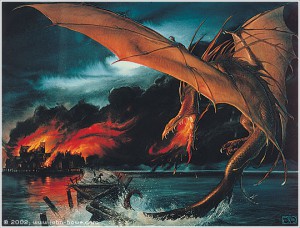
However, he also noted that the Númenóreans, at any rate, were “tall, taller than the tallest of the sons of Middle-earth”[20] — which would, presumably, include Elves—and that, specifically, many such Men reached between six-and-a-half and seven-feet tall![21] While the great stature of the Númenóreans and their descendants in Gondor and Arnor was anomalous in the Second and Third Ages, it was even then not unique. Eómer of Rohan was “said to have been tall, of like height with Aragorn”[22] and even the Northern Man Bard is described as “tall” and yielding a “great yew bow”[23] — clearly indicating he was a more imposing physical figure than his contemporaries in Esgaroth.
Both considerable strength and height seemed to be crucial in killing the fire-breathing leviathans of Middle-earth. Turin killed Glaurung — as Sigurd did Fáfnir[24] — by striking up at the soft underbelly from beneath. Tolkien did not detail how Fram dispatched Scatha, but since he was a flightless “long worm”, like Glaurung, it’s probable that the Éothéod prince also used a sword or spear against that dragon in like fashion to how Turin had done so.
Bard’s black arrow, famously, brought down Smaug the Magnificent, but only because it was launched by one with “the sinews of the Kings of Men”.[25] As for Eärendil’s battle with Ancalagon, Tolkien again did not mention the exact weaponry used, although a “wavering flame” and a Silmaril[26] may have been what overpowered the dragon. Also, while Eärendil may have been half-Elven, “his heart was rather with the kindred of Men and the people of his father”[27] —- and thus one might argue that all four dragon-slayers of Middle-earth history were Men, and that with the possible exception of this famous First Age mariner and interceder with the Valar, Men of greater physical power than even the legendary Elf warriors.
Another possible theory as to why Men killed dragons in Tolkien’s world is, admittedly, more speculative and complex: because dragons, despite their possible creation by Morgoth[28] and indwelling by evil spirits[29], were nonetheless chiefly corporeal threats — not preternatural ones. Dragons wreaked havoc by virtue of their vast size and power, especially their ability (the ones that had it — for not all did) to breathe fire. (Glaurung was a partial exception to this, in that he was also capable of luring Men like Turin into evil plots[30] — but even there the dragon was going beyond mere physical ruin at the behest of Morgoth, and not of his own initiative.)
Thus, rather mundanely, a large and powerful hero with some kind of keen blade or projectile was needed to stop a dragon, the best-armored behemoth of Middle-earth. Dragons were even greater in size than either Dark Lord, Sauron or Morgoth, of whom the former Tolkien said “[t]he form that he took was that of a man of more than human stature, but not gigantic;”[31] while of the latter that, in his battle with Fingolfin, he was “like a tower, iron-crowned, and his vast shield… cast[ing] a shadow… like a stormcloud.”[32]
Footnotes:
[16] Turin was exceeded in battle by only one man: his father, Húrin, “the mightiest of the warriors of mortal Men” (“Of the Ruin of Doriath”, The Simlarillion, ,p. 232) who single-handedly slew 70 trolls before being captured and taken as a prisoner to Morgoth (“Of the Fifth Battle”, p. 195).
[17] The Children of Hurin, p. 81.
[18] Ibid., p. 89.
[19] “Of Men”, The Silmarillion, p. 104.
[20] “Akallabêth”, The Silmarillion, p. 261.
[21] “Appendix: Númenórean Linear Meaasures”, “Disaster of the Gladden Fields”, in Unfinished Tales, pp. 285-287. Thus the later term for Hobbits, “Halflings,” was intended, originally, as an exact description of their height: half that of a Númenórean.
[22] Ibid., p. 286.
[23] The Hobbit, pp. 224-225.
[24] http://en.wikipedia.org/wiki/Fafnir
[25] LOTR, p. 268. These are the words spoken by Boromir at the Council of Elrond in doubt about Aragorn’s lineage — but mutatis mutandis, we can apply them to Bard, who indeed became the King of Dale.
[26] “Of the Voyage of Eärendil”, p. 250.
[27] Ibid., p. 249. He chose, rather reluctantly, to be deemed an Elf in order not to be separated from his wife, Elwing.
[28] In “Akallabêth”, p. 260, it is said that after the War of Wrath “Men… were troubled by many evil things that Morgoth had devised in the days of his dominions: demons, and dragons, and misshapen beasts, and the unclean Orcs… .” [emphasis added].
[29] The Children of Hurin, p. 178.
[30] Ibid., pp. 178-181.
[31] Letters, p. 322.
[32] “Of the Ruin of Beleriand”, p. 153.


